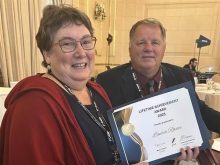It took some time for John Towle to get to the door after leaving the stage of the Manitoba Association of Watersheds awards banquet in early December. It seemed like every other person wanted to shake his hand.
In his grip, Towle carried an inscribed paddle, the mark of his Distinguished Service Award, just presented to him by the Canadian Water Resources Association (CWRA).
“This,” he said, gesturing to the award in his hand. “Sitting here looking at it in the evenings, I’ll remember all my connections.”
Read Also

Cooking cabbage deserves revival
Cabbage recipes don’t need to be boring. Rediscover the taste, diverse uses and local Prairie food traditions of this leafy green
Why it matters: John Towle has collected a vast sum of experience after 40 years promoting water management in the province.
When it comes to water conservation advocates in Manitoba, connections are one thing that, after 40 years of involvement, Towle has in plenty.
A national non-profit focused on water resource issues, the CWRA counts the award as “the most distinguished award that is presented to a CWRA member or past member who had provided distinguished service to the Canadian water resources community,” Manitoba branch director Carly Delavau said during the award ceremony Dec. 7.
Towle has been “instrumental in spearheading the consensus and grassroots level involvement in regional watershed and basin planning processes at a time when Manitoba did not even have a formal watershed planning process,” she said.
It was the seventh time a Manitoban has been named to the award since its inception in 1975.
Towle was actually named in May, during the CWRA’s annual meeting. Due to the pandemic, however, the organization was forced to hold the event virtually, with considerably less pomp and circumstance than the CWRA would have preferred.
The Manitoba Association of Watersheds conference, held in early December in Brandon, provided an opportunity to do the award and its recipient justice, the CWRA decided.
Mapping uncharted waters
Is it not hyperbole to say that Manitoba’s water management landscape might look very different today without John Towle.
Starting on the staff of the now-defunct Prairie Farm Rehabilitation Administration in Saskatchewan, Towle eventually set down roots in Manitoba as the northwest regional water manager in 1981, under the then-named Manitoba Natural Resources branch of the provincial government.
It was in that role that Towle first dug into Manitoba’s fledgling conservation district system. At that time, the conservation district roster only counted five members — the Turtle Mountain, Whitemud, Cooks Creek, Alonsa and Turtle River districts, all launched in the ’70s and, with the exception of the Cooks Creek district east of Winnipeg, all in western Manitoba.
Towle served two of those, the Turtle River Conservation District and Alonsa Conservation District, as provincial co-ordinator out of his office in Dauphin.
Over the intervening decades, Towle watched that system expand into 18 conservation districts covering much of agro-Manitoba, before amalgamating into 14 larger watershed districts last year — a shift that has come with expanded workloads, new funding streams, and new jurisdiction for partnerships, district managers have said.
“It’s fantastic,” Towle said, looking at the system’s growth. “This province is really working hard to understand water management — and soil health. Now we’re doing a lot more on soil health.”
Towle’s name eventually became a consistent theme in all things water. He got involved with projects like the Dauphin Lake Basin Advisory Board and helped develop guidelines that would eventually become official provincial policy on watershed planning.
In the late ’90s, he helped development management plans for the Assiniboine Delta Aquifer, a project that he remembers to this day as one of the most challenging of his career, with sticking points around water allocations for irrigation, concerns over groundwater supply and, he said, significant amounts of misinformation.
“Now with these droughts, I’m glad they have that plan to work with,” he said.
In 1996, his job shifted. Towle started a new role as manager of water planning and communications within the same department of the provincial government.
As it turned out, it was just in time for circumstances to test Towle’s mettle. The following spring saw flood waters rise, and left Towle with the unenviable task of being a water management specialist during what would later be dubbed the Flood of the Century.
Over the years, his list of roles has grown: Manitoba director for the CWRA, president of the CWRA’s Manitoba Branch, mentor and consultant for various advisory boards and one of the key names behind Manitoba’s Envirothon, among others.
Today, despite retiring in 2003, Towle is still very much in touch with Manitoba’s “water community” and to his local watershed around Dauphin — including an assisting part in transitioning the now Inter-Mountain Watershed District from its conservation district roots.
He has, in fact, extracted a tongue-in-cheek promise from the manager of that watershed district, he said — the district has to install 100 new water retention projects within Towle’s lifetime, and another 100 afterwards.
“Hopefully, we can get all of agricultural Manitoba into conservation programs,” he said of the future. “It depends upon the local governments and people’s attitudes. If they know they can get money and cost sharing for projects, I don’t know why they don’t join.”
















